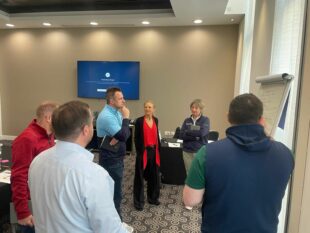On the latest episode of GCMA Insights, on the Golf Club Talk UK podcast, STRI Group’s James Podesta explains how taking a longer view of a club’s assets can bring rewards…
This article is part of GCMA Insights – topical content for golf industry professionals, discussing the things that matter to those who work in golf clubs.
Here’s what the STRI Group are not doing. They are not encouraging your club to sell off holes to fund development projects.
But do they have some surplus land which might be put to better use? If that’s the case, they can find out how to make the most of that in the latest edition of GCMA Insights on the Golf Club Talk UK podcast.
James Podesta, head of development at STRI Group, joined host Leighton Walker to talk about the work they are doing in helping clubs take a longer-term view of their assets, or facilities, and how they can be improved going forward.
“It could be very simple operations, in terms of how sites work, and how they operate themselves, right up to new developments – constructions and buildings,” he said.

Get involved in the debate.
To join the GCMA, click here, or to organise a call with a member of the GCMA team, just complete the form below.
He added: “Sporting clubs are custodians of very large pieces of lands – 40+ hectares for a traditional 18-hole course in very high landscape value areas.
“We’re not encouraging golf clubs at all to artificially find land to sell off to produce income but, in certain circumstances, these situations may occur.
“When they do, there are a number of different things that clubs can look to do with that land – from ecology right through to potential commercial opportunities, or indeed residential opportunities, as well as the potential to redevelop aspects of the club for a number of different uses as well.”
Podesta said it would be obvious to most clubs whether they had additional land that was surplus to requirements. The key was to look at that land, assess the variables, and then bring in experts.
“The initial approach is to assess what you’ve got,” he explained. “It sounds straightforward but there are a number of different ways of looking at that.
“You have the ecological landscape value of a particular venue and that’s easy enough for us to have a look at and give some value to and then you also have the opportunity value that’s there.
“You start to have a look at the surroundings and the existing environment and what’s adjacent to the site. Does it lend itself to any other development opportunities?
Are you adjacent to a roadside? Are you adjacent to commercial developments or residential developments?”
WHY JOIN THE GCMA?
Membership of the GCMA unlocks a network of like-minded professionals, provides you with support in your professional and personal development, and provides you with a multitude of benefits. Whether that’s the tools that will help you to excel in your profession, or a wide range of services to support your wellbeing, signing up to the GCMA is joining a community.
He added: “You start looking at all those different variables and you start to pull a picture together of what is the art of the possible on this piece of land? That’s where you have to potentially bring in different levels of experts.”
Podesta said the result would be a development proposal, that would set out the opportunities, potential risks, and upsides of a potential site and that could be produced by STRI Group’s in-house experts.
To listen to the podcast, and to learn more about STRI Group’s work in development, click the player above or visit the Golf Club Talk UK podcast site.
This article is part of GCMA Insights – topical content for golf industry professionals, discussing the things that matter to those who work in golf clubs.
Get involved in the debate. To join the GCMA, click here, or to organise a call with a member of the GCMA team, just complete this form and we’ll be in touch!
Enquiries
"*" indicates required fields



